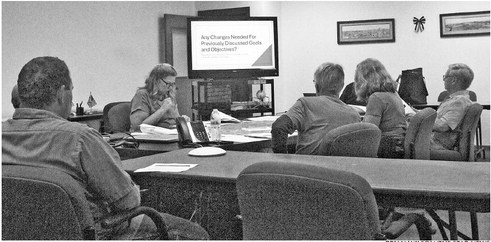Forestry committee talks about invasive species, sign placements


The expansion of invasive species such as buckthorn could have a big impact on future county forest management unless efforts are made to control them.
The topic of invasive species control was raised during the September 6 forest and recreation committee.
According to county forest administrator Lucas Williams, they encountered fairly significant amounts of buckthorn while doing clean-up work along the Pine Line Rail trail. This woody shrub will grow up to about 30 feet tall and crowd out native timber.
During the clean up, which removed storm damaged trees from storms early this summer, they removed two to three loads of wood and 17 loads of brush. He noted that they will have to dispose of some of the logs elsewhere because the city waste yard will not accept logs over 8 inches in diameter.
Williams noted that it can be a challenge to entirely remove if it is allowed to get established. Fortunately, he said within the county forest there are currently very low levels. However, he cautioned of the need to prevent it from spreading because of the negative impact it would have on logging and other forest use. Once established, buckthorn management includes cutting it back and treating the stumps with herbicide.
A challenge along the Pine Line is that the Rail Trail is only a relatively narrow corridor and the buckthorn stands extend further back onto the adjoining private property along the trail. Any buckthorn management along the trail would require partnership with adjoining landowners.
Other invasive species concerns include the spread of Japanese Knotweed and garlic mustard in addition to the eventual spread of emerald ash borer north from the Medford area into the forest.
Committee chairman Scott Mildbrand said people care about their land and would work to combat invasive species if they were more aware of them and what they should be doing.
Williams suggested people contact the Natural Resources Conservation Service or the local Department of Natural Resources office for help identifying unfamiliar plants to find out if they are invasive and what can be done to mitigate them.
Williams noted that one easy way to identify buckthorn and other similar invasive species is to check in November after all the other leaves are brown because buckthorn will still have green leaves.
Committee members suggested holding a workshop or participating in an event where they could help educate the public about the risks of invasive species.
In other business, committee members
• Approved allowing a sign to be installed near the road entrance for a wildlife habitat management area within the county forest. The county is working in partnership with UW-Stevens Point for an area of the forest that is being managed by university students under the direction of university staff for neotropical migratory birds.
Williams explained that the program is federally funded and that the sign is being paid for through federal grant funds with the university handling installation. The county just had to give permission about where the sign will be located.
Mildbrand said he felt it was important that the county work with UW-Stevens Point to educate the next generation of foresters.
Williams noted that specific program allows the participants to earn a wildlife management certificate and includes focus on forest management for different types of wildlife. He said the people using it will include students as well as practicing foresters who are going for their certification.
Williams, who has partially completed the certification program himself, noted the management for neotropical migratory species is very similar to management practices for game species, and noted this will be beneficial for local sportsmen.
The major concern with installing the sign was the amount of damage that could occur due to vandalism. Assistant forest administrator Alex Solawetz suggested putting the sign along the road rather than at an intersection.
“Most of the signs in the Taylor County Forest have bullet holes in them,” he said.
Taking his point, committee members still favored having the sign placed in a more visible location where people might see it more.
• Approved the annual work plan and the annual achievement list. These reports are required to be approved by both the DNR and by the full county board in order for the county to continue to receive state grant funds to help pay the county forest administrator wages.
• Received an update on logging sales. There were three different contractors working on five separate jobs within the county forest.
• Discussed having to return about $800 of snowmobile trail funds to the state. The county receives a $47,000 advance in snowmobile trail maintenance funds each year and with the mild winter not all of it was used by the snowmobile clubs. Williams said that he was advised by the DNR to not put themselves in the position to have to return funds in the future and instead put it to other trail projects. It was noted this was an unusual circumstance given the winter conditions. Generally the local trail maintenance efforts go through the state funding completely and must seek supplemental funding.

